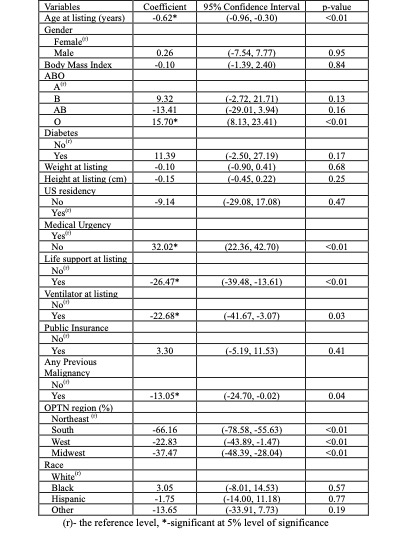Racial equity in intestine transplantation in the United States
Ruhul Kuddus1, Mohammad Islam2.
1Biology, Utah Valley University, Orem, UT, United States; 2Mathematics, Utah Valley University, Orem, UT, United States
Background: Advances in immunosuppressive drugs, infection control, and surgical techniques have turned intestinal transplantation into a customary treatment for terminal intestinal failure. Data on candidates wait-listed for an intestine transplantation between October 1991 and September 2023 was obtained from the Organ Procurement and Transplantation Network (OPTN). This study analyzes potential racial disparities in access to intestinal transplantation in the United States using the OPTN data.
Methods: Out of the 5615 cases archived between Oct 1991 to Sept 2023 by OPTN, we excluded 2,749 cases because of data insufficiency. Sex, age, body mass index, health conditions at the listing, insurance situation, and regional distribution for the remaining 2866 patients were analyzed. Since the output variable (i.e., waiting time) was non-normal, the Kurskal-Wallis test with Bonferroni correction and a rank-based regression model were applied to investigate the equality of median days in the waiting list. Pairwise comparison on medium waiting was analyzed using the Wilcoxon-Rank-sum test. A non-parametric bootstrap method was used to construct a 95% confidence interval to reduce the effect of outliers on regression coefficient and hypothesis testing.
Results: The patients with full data set included 66% White, 16.6% Black, 13.8% Hispanic, and 0.03% of other background. Males (55%) outnumbered females (45%) among all ethnic groups except whites (49.8%). Mean age at listing for white patients was higher than other ethnic groups (p=0.01), and white patients had higher BMI (20.42) and comprised more diabetics and patients with malignancies compared to other ethnic groups (p<0.001). Black patients had higher medical urgency than other ethnic groups (p<0.001), while more Black and Hispanic patients had public health insurance (p<0.001) (Fig. 1).

There was a significant disparity in the distribution of patient ethnicity in four OPTN regions (p<0.001). The median waiting period was 81, 105, 100, and 90 days for White, Black, Hispanic, and other patient groups, respectively (p<0.001). Black patients waited 23 more days than white patients (p=0.01). However, after adjusting confounding factors, the rank-based regression analysis showed that the effect of ethnicity on median days of waiting for an intestine transplant was not statistically significant (Fig. 2).

Conclusions: While unadjusted analyses demonstrated significant differences in median waiting time among racial groups, the adjusted rank-based regression analysis did not find race to be a significant factor in waiting time for getting an intestine transplant in the United States after accounting for other medical attributes.
Utah Valley University for reassigned time for research.
[1] Intestine transplantation, median waiting time, racial equity
